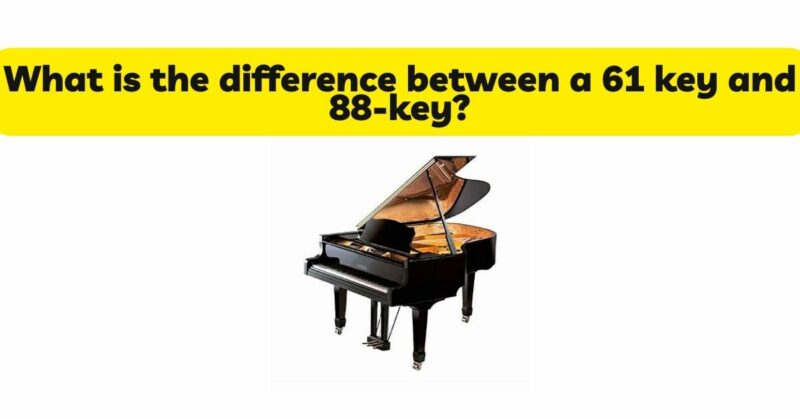When it comes to choosing a keyboard, understanding the differences between a 61-key and an 88-key instrument is essential. The number of keys on a keyboard significantly impacts its range, versatility, and suitability for different musical genres and playing styles. This article aims to shed light on the distinctions between 61-key and 88-key keyboards, helping you make an informed decision based on your musical aspirations, skill level, and genre preferences.
Understanding Keyboard Sizes:
- 61-Key Keyboards: A 61-key keyboard, also known as a five-octave keyboard, provides a compact and portable option for musicians. It typically spans from C1 to C6 and is often favored by beginners, space-conscious individuals, or those primarily interested in popular music genres. While it offers a reduced range compared to larger keyboards, it is still capable of accommodating a wide variety of musical styles and allows for basic melody and chord playing.
- 88-Key Keyboards: An 88-key keyboard, also referred to as a full-sized keyboard, replicates the range and layout of a traditional acoustic piano. It spans from A0 to C8, encompassing a complete range of seven octaves. This size is commonly found in both acoustic pianos and higher-end digital keyboards, catering to pianists of all skill levels and offering versatility across various musical genres.
Key Differences Between 61-Key and 88-Key Keyboards:
- Range: The most apparent difference between 61-key and 88-key keyboards is the range they offer. An 88-key keyboard provides a broader range, encompassing more octaves and notes compared to a 61-key keyboard. With 88 keys, you can access a wider spectrum of low and high notes, allowing for the full expression of musical compositions. In contrast, a 61-key keyboard has a more limited range, which may restrict the playing of certain pieces or intricate musical arrangements.
- Repertoire and Musical Genres: The range of a keyboard directly influences the repertoire and musical genres that can be effectively played on the instrument. An 88-key keyboard is ideal for classical, jazz, and piano-based compositions that often require a wider range of octaves and complex chord progressions. It allows for the full expression of various musical nuances and provides greater versatility for exploring different styles and genres. Conversely, a 61-key keyboard is well-suited for popular music genres like pop, rock, or electronic music, which typically rely on simpler chord structures and melodies within a more limited range.
- Playing Technique and Skill Development: The expanded range of an 88-key keyboard offers advantages in terms of playing technique and skill development. It allows for the exploration of advanced playing techniques, intricate fingerings, and wider chord voicings. Aspiring pianists looking to develop a nuanced touch and expressiveness in their playing may find the 88-key keyboard better suited to their needs. However, beginners may still benefit from starting with a 61-key keyboard to build foundational skills before transitioning to the broader range of an 88-key instrument.
- Expression and Dynamics: An 88-key keyboard provides a greater opportunity for dynamic expression due to its wider range. With access to a broader spectrum of notes, pianists can utilize a wider range of dynamics, including soft pianissimo passages and powerful fortissimo sections. The additional keys allow for more nuanced phrasing and a more authentic replication of the expressive capabilities of an acoustic piano. While a 61-key keyboard can still offer some dynamic expression, its more limited range may restrict the full potential of dynamics in musical performances.
- Space Considerations and Portability: The size and portability of a keyboard should also be considered when choosing between a 61-key and 88-key instrument. A 61-key keyboard is more compact and easier to transport, making it suitable for musicians with limited space or those who require a portable option. On the other hand, an 88-key keyboard, mirroring the size of an acoustic piano, requires more space and may be less practical for those with space constraints or a need for frequent transportation.
- Cost: The cost is another differentiating factor between 61-key and 88-key keyboards. Generally, 88-key keyboards tend to be more expensive than their 61-key counterparts. The larger size, expanded range, and higher-quality construction required for an 88-key instrument contribute to its higher price. While budget is an important consideration, it’s essential to balance your financial resources with the desired range and features to find the right instrument for your needs.
Conclusion:
Choosing between a 61-key and 88-key keyboard depends on several factors, including your musical aspirations, preferred genres, skill level, available space, and budget. An 88-key keyboard offers a broader range, better replicates the feel and range of an acoustic piano, and is suitable for a wider range of musical genres. It is favored by pianists looking for versatility, expression, and access to a wider repertoire. A 61-key keyboard, while more limited in range, provides a compact and affordable option that is well-suited for beginners or those primarily interested in popular music genres.Consider your musical goals, playing style, available space, and budget when making your decision. Remember that the most important aspect is to choose a keyboard that aligns with your musical aspirations and provides an instrument that inspires and supports your progress as a musician.

